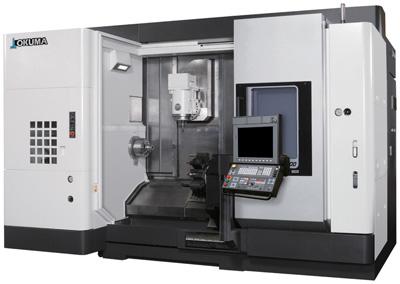
Okuma America Corp. announces its new MULTUS U Series general-purpose multitasking CNC lathes, which are designed to reduce setup time, improve accuracy and keep non-cutting time to a minimum. The series includes two machine sizes: the MULTUS U3000 and the MULTUS U4000. The MULTUS U Series lathes are equipped with a comprehensive package of Okuma's Intelligent Technologies (Thermo-Friendly Concept, Collision Avoidance System and Machining Navi) and a variety of efficiency features which make them "intelligent multitasking machines."
Built with Okuma's heavy-duty construction, the MULTUS U series CNC lathes provide a robust platform for long-term rigidity and accuracy. They are excellent for machining process-intensive parts, such as those in Aerospace, Oil/Energy, Medical and Construction, and provide a complete multitasking solution:
Flexible CNC machining from all directions — A highly rigid traveling column allows for powerful cutting along the entire Y-axis.
Extended specs for a variety of applications — 17 diverse variations in specs, including multiple bed lengths, optional sub-spindle (W-Axis) and optional lower turret, provide a specific solution that matches application requirements.
Maximum Milling or Turning Performance — For highly-efficient cutting of difficult-to-machine materials and a wide variety of CNC machining applications.
Thermo-Friendly Concept — Provides long, stable machining accuracy with thermo-static design and thermal deformation control technology.
Shorter Setup Time and Prevention of Collisions — The OSP-P300S control reduces keyboard operations by 50 percent and maximizes uptime with its Collision Avoidance System.
Machining Navi — Maximizes tool performance by choosing the optimal speed(s) at which the machine can avoid chatter.
Operator-Friendly Design — Easy tool loading from the machine front, improved spindle access for faster setup times, and smooth chip discharge for better chip flow.
Contact Details
Related Glossary Terms
- chatter
chatter
Condition of vibration involving the machine, workpiece and cutting tool. Once this condition arises, it is often self-sustaining until the problem is corrected. Chatter can be identified when lines or grooves appear at regular intervals in the workpiece. These lines or grooves are caused by the teeth of the cutter as they vibrate in and out of the workpiece and their spacing depends on the frequency of vibration.
- computer numerical control ( CNC)
computer numerical control ( CNC)
Microprocessor-based controller dedicated to a machine tool that permits the creation or modification of parts. Programmed numerical control activates the machine’s servos and spindle drives and controls the various machining operations. See DNC, direct numerical control; NC, numerical control.
- gang cutting ( milling)
gang cutting ( milling)
Machining with several cutters mounted on a single arbor, generally for simultaneous cutting.
- milling
milling
Machining operation in which metal or other material is removed by applying power to a rotating cutter. In vertical milling, the cutting tool is mounted vertically on the spindle. In horizontal milling, the cutting tool is mounted horizontally, either directly on the spindle or on an arbor. Horizontal milling is further broken down into conventional milling, where the cutter rotates opposite the direction of feed, or “up” into the workpiece; and climb milling, where the cutter rotates in the direction of feed, or “down” into the workpiece. Milling operations include plane or surface milling, endmilling, facemilling, angle milling, form milling and profiling.
- multifunction machines ( multitasking machines)
multifunction machines ( multitasking machines)
Machines and machining/turning centers capable of performing a variety of tasks, including milling, drilling, grinding boring, turning and cutoff, usually in just one setup.
- turning
turning
Workpiece is held in a chuck, mounted on a face plate or secured between centers and rotated while a cutting tool, normally a single-point tool, is fed into it along its periphery or across its end or face. Takes the form of straight turning (cutting along the periphery of the workpiece); taper turning (creating a taper); step turning (turning different-size diameters on the same work); chamfering (beveling an edge or shoulder); facing (cutting on an end); turning threads (usually external but can be internal); roughing (high-volume metal removal); and finishing (final light cuts). Performed on lathes, turning centers, chucking machines, automatic screw machines and similar machines.

